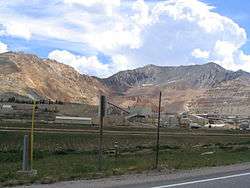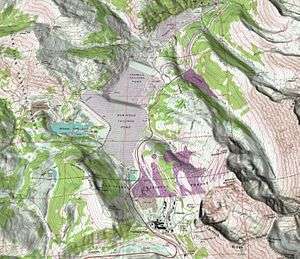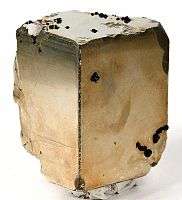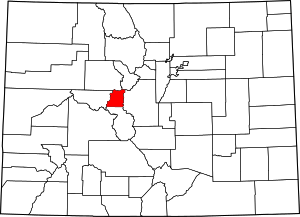Climax, Colorado
Climax was an unincorporated mining village and a former U.S. Post Office located in Lake County, Colorado, United States.[2] Climax is known for its large molybdenum ore deposit. Climax is located along the Continental Divide at an elevation of about 11,360 feet (3465 meters). It was the highest human settlement in the United States, and it holds the record for having had the country's second highest Post Office and the highest railroad station. The residential houses were all transported to the West Park subdivision of Leadville, Colorado, before 1965, leaving only the mining buildings standing.
Climax, Colorado | |
|---|---|
Town | |
 Climax mine, 2005 | |
 Climax Location in Colorado  Climax Location in the United States | |
| Coordinates: 39°21′57″N 106°11′09″W | |
| Country | |
| State | |
| County | Lake County |
| Government | |
| • Type | unincorporated community |
| Elevation | 3,463 m (11,360 ft) |
| Time zone | UTC-7 (MST) |
| • Summer (DST) | UTC-6 (MDT) |
| ZIP Code (former) | 80429[1] |
After a 17-year shutdown, the Climax mine has reopened and resumed shipment of molybdenum on May 10, 2012.
History
Climax's reason for being is its huge deposit of molybdenum ore. The Climax mine was the largest molybdenum mine in the world, and for many years it supplied three-fourths of the world's supply of the metal.[3] Over the years it evolved from "at times the largest underground mine in the world,"[4] into a pit mine.
The village of Climax is now considered to be a ghost town. The former Colorado & Southern Railway line from Leadville is now operated as a tourist line by Leadville, Colorado & Southern Railroad. The line stops at an overview of the Climax Molybdenum Mine and Fremont Pass. Climax is also a destination for automobile tourists, bicyclists, and photographers, but lacking commercial enterprise, the location is not well advertised.
Notable people
- Erbey Satterfield, Utah state legislator, was born in Climax.[5]
- Dave Gorsuch, Olympian, was born in Climax.[6]
- Billy Wilder, shot his movie Kiss Me Stupid - partly- in Climax,
Climate
With a mean annual temperature of 30.7 °F or −0.7 °C, Climax is not only the highest but also the coldest settlement ever established in the contiguous US, being probably the only one with a mean annual temperature below freezing point. The town has a borderline subalpine climate (Köppen Dfc), closely bordering on an alpine climate (ETH) with short, mild summers and long, snowy winters. The annual snowfall is, as would be expected, extremely heavy at 282.3 inches or 7.17 metres, with the record for a full season being 383.0 inches (9.73 m) between July 1961 and June 1962, and the most in one month 105.3 inches (2.67 m) during December 1983. Snow does not melt until June and after wet winters may accumulate into May – the maximum daily snow cover was 81 inches or 2.06 metres on May 7, 1984. Precipitation falls off in June, but the tail end of the monsoon may cause thunderstorm activity in July and August. The wettest calendar year has been 2014 with 32.81 inches (833.4 mm) and the driest 1989 when only a water equivalent of 13.53 inches (343.7 mm) was gauged.
The high elevation means that Climax has consistently cold temperatures throughout the year, with frosts possible in any month and 51.4 mornings falling to or below 0 °F or −17.8 °C. The average window for zero temperatures is from November 7 to April 7, though temperatures that low have been reported as late as May 11, 1953 and as early as October 10 of 1982. Climax’s 109.3 days that do not top freezing is also the most in the contiguous US – the average window for days not topping freezing being from October 13 to May 6, and cases as late as June 25, 1969 and as early as September 3 of 1961 are known. The high altitude, however, limits extreme minima as in the coldest weather Climax may be warmer than lower valleys; the record low being −33 °F (−36.1 °C) on January 12, 1963 and December 23, 1990. The hottest temperature has been 85 °F or 29.4 °C on July 7, 1981; 1981 was also the hottest full year at 33.3 °F or 0.7 °C, whilst 1973 with an annual mean of 28.7 °F or −1.8 °C is the coldest calendar year. The hottest month has been July 2003 with a mean of 58.1 °F or 14.5 °C; the coldest has been January 1979 which averaged 6.1 °F or −14.4 °C.
| Climate data for Climax, Colorado (Elevation 11,300 feet or 3,440 meters) | |||||||||||||
|---|---|---|---|---|---|---|---|---|---|---|---|---|---|
| Month | Jan | Feb | Mar | Apr | May | Jun | Jul | Aug | Sep | Oct | Nov | Dec | Year |
| Record high °F (°C) | 50 (10) |
53 (12) |
57 (14) |
59 (15) |
71 (22) |
78 (26) |
85 (29) |
84 (29) |
82 (28) |
73 (23) |
60 (16) |
52 (11) |
85 (29) |
| Average high °F (°C) | 25.2 (−3.8) |
27.3 (−2.6) |
33.0 (0.6) |
38.6 (3.7) |
47.2 (8.4) |
58.5 (14.7) |
64.8 (18.2) |
62.1 (16.7) |
56.1 (13.4) |
44.5 (6.9) |
32.8 (0.4) |
24.7 (−4.1) |
43.0 (6.1) |
| Average low °F (°C) | 1.9 (−16.7) |
2.0 (−16.7) |
6.7 (−14.1) |
12.9 (−10.6) |
23.3 (−4.8) |
32.9 (0.5) |
39.0 (3.9) |
37.9 (3.3) |
30.3 (−0.9) |
20.0 (−6.7) |
9.3 (−12.6) |
2.0 (−16.7) |
18.3 (−7.6) |
| Record low °F (°C) | −33 (−36) |
−32 (−36) |
−24 (−31) |
−20 (−29) |
−10 (−23) |
10 (−12) |
12 (−11) |
18 (−8) |
6 (−14) |
−9 (−23) |
−27 (−33) |
−33 (−36) |
−33 (−36) |
| Average precipitation inches (mm) | 2.31 (59) |
2.09 (53) |
2.46 (62) |
2.63 (67) |
2.03 (52) |
1.30 (33) |
2.37 (60) |
2.40 (61) |
1.56 (40) |
1.47 (37) |
1.90 (48) |
2.20 (56) |
24.72 (628) |
| Average snowfall inches (cm) | 40.4 (103) |
37.6 (96) |
41.2 (105) |
40.3 (102) |
20.1 (51) |
4.9 (12) |
0.3 (0.76) |
0.2 (0.51) |
5.7 (14) |
18.7 (47) |
32.2 (82) |
38.8 (99) |
280.4 (712.27) |
| Average precipitation days (≥ 0.01 inch) | 16 | 14 | 16 | 14 | 11 | 8 | 13 | 15 | 10 | 9 | 12 | 14 | 152 |
| Average snowy days (≥ 0.1 inch) | 16 | 15 | 16 | 13 | 9 | 2 | 0 | 0 | 2 | 7 | 12 | 15 | 107 |
| Source: The Western Regional Climate Center[7] | |||||||||||||
Gallery
 Climax, Colorado straddles the continental divide at Fremont Pass
Climax, Colorado straddles the continental divide at Fremont Pass Storm over Sheep Mountain just north of Climax, 2005.
Storm over Sheep Mountain just north of Climax, 2005. A rare pyrite-tetrahedrite mineral specimen from Climax
A rare pyrite-tetrahedrite mineral specimen from Climax
References
- "ZIP Code Lookup". United States Postal Service. December 15, 2006. Archived from the original (JavaScript/HTML) on September 3, 2007. Retrieved December 15, 2006.
- "Climax, Colorado (historical)". Geographic Names Information System. United States Geological Survey.
- "Mining A Mountain" Popular Mechanics, July 1935 pp.63-64
- The History of Colorado’s Climax Mine, by Steve Voynick, 1996:
- Erbey Leland Satterfield-obituary
- Evans, Hilary; Gjerde, Arild; Heijmans, Jeroen; Mallon, Bill; et al. "Dave Gorsuch Olympic Results". Olympics at Sports-Reference.com. Sports Reference LLC. Archived from the original on April 18, 2020. Retrieved March 11, 2018.
- "NCDC 1981-2010 Normals". Western Regional Climate Center. Retrieved August 9, 2018.
Further reading
- Paul B. Coffman (1937). "The Rise of a New Metal: The Growth and Success of the Climax Molybdenum Company". The Journal of Business of the University of Chicago. 10 (1): 30–45. doi:10.1086/232443. JSTOR 2349563.
- Voynick, Steve (2004). "Climax, Two Decades Later". Colorado Central Magazine. 125: 16. Archived from the original on 2006-10-14. Retrieved 2004-12-05.
| Wikimedia Commons has media related to Climax, Colorado. |
